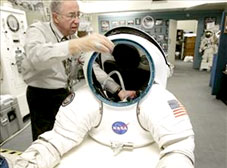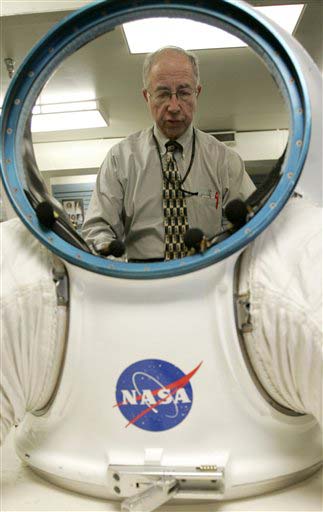NASA develops new space attire
At the Johnson Space Center Laboratory of the US National Aeronautics Agency (NASA), a group of engineers is working hard to assemble new space suits.

Model of space clothing is being developed at Johnson center.Photo: Reuters
For decades, astronaut costumes have been greatly improved from Mercury's aluminum shirt to the 124-kilogram white outfit currently used to walk out into space. Not knowing how new clothes are designed, but NASA hopes to design high-tech suits at low cost.
Current US space apparel is easy to move and durable but complex and expensive. Meanwhile, Russia's 'one size for all' shirt can be used several times, but difficult to move. Therefore, the top priority in NASA's new costume design is to be more compact.
Engineers hope to reduce nearly half of the nearly 90 kilograms of clothing that has life support devices that Apollo astronauts used to carry. NASA intends to use new composite materials and take advantage of smaller electronic devices to reduce weight and move more easily.
New space attire must have some characteristics such as extreme heat and cold tolerance as well as preventing radioactivity and operation with less energy consumption because the outfit's oxygen-rich air can escape quickly. out and cause fire. NASA intends to launch its first outfit in 2010 and launches massively in 2012, near the time Orion ships into space.

(Photo: media.bonnint.net)
N.MINH
- Things you didn't know about NASA
- NASA develops supersonic passenger aircraft
- Nasa develops 10 electric motors
- NASA spends money on Boeing to go to space but may have to 'hitchhike' Russia
- NASA proposes to build a space taxi
- NASA set up funding for taxi systems in space
- How much does NASA pay for each ticket to space?
- Historical landmarks for NASA's 60 years of space exploration
- South Korea spends $ 1.85 billion to develop new boosters
- NASA develops a solar-powered engine that puts people on Mars
- The world has some space agencies, do you know?
- NASA launched a spacecraft after delaying
 Van Allen's belt and evidence that the Apollo 11 mission to the Moon was myth
Van Allen's belt and evidence that the Apollo 11 mission to the Moon was myth The levels of civilization in the universe (Kardashev scale)
The levels of civilization in the universe (Kardashev scale) Today Mars, the sun and the Earth are aligned
Today Mars, the sun and the Earth are aligned The Amazon owner announced a secret plan to build a space base for thousands of people
The Amazon owner announced a secret plan to build a space base for thousands of people